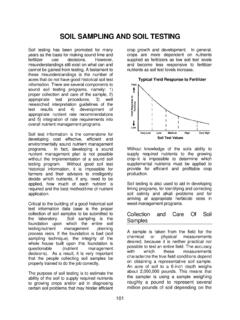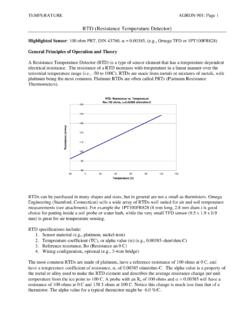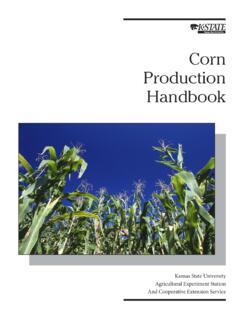Transcription of SOILS, SOIL CHARACTERISTICS AND SOIL MANAGEMENT
1 SOILS, SOIL CHARACTERISTICS AND SOIL MANAGEMENT Introduction 1 The success of many civilizations has been determined by the quality of their soil resources. Furthermore, most civilizations have remained great only as long as they have properly managed the soil. Many productive soils have been worn out by depleting the fertility and allowing excessive erosion. Modern day use of fertilizer can help replenish fertility, but good soil MANAGEMENT is still important to maintain high productivity. Soils differ greatly in their ability to produce agricultural crops. Our soils have developed from a diversity of materials and under a wide range of environmental conditions.
2 This chapter will discuss soils and factors affecting their productivity. What Is Soil? Soil is the upper weathering layer of the solid earth surface in which plants growand is a mixture of minerals, organic matter (humus), air, and water (Figure 1). An ideal soil is about 50% solids consisting of mineral and organic material. The organic portion consists of residues of plants, animals, and other living organisms. Levels vary, but in most Great Plains soils, levels of less than 1% to 5% on a weight basis are typical. Under optimum conditions for plant growth, about half of the pore space is filled with water, leaving the remainder of the pores filled with air.
3 This mixture of mineral and organic material, water, and air provides the environment for root growth. Soil compaction reduces pore space, soil aeration, and permeability which restricts root growth and nutrient uptake. Soils vary in their chemical, physical and biological CHARACTERISTICS . Because of these inherent differences in CHARACTERISTICS , soils have different use capabilities. They respond differently to various cropping, tillage, fertility, and irrigation practices. Soil scientists use the inherent CHARACTERISTICS of soils to give them distinct, identifying names. They use the same CHARACTERISTICS to group soils into land use classes.
4 Successful farmers learn to use this information to their best advantage. Soils are like people in that we must know them thoroughly in order to understand them; in order to understand which practices will enhance their worth their productivity. There are 17 different nutrient elements that are essential for plant growth; of these, 14 are derived primarily from the soil. Soil also provides a place to store water and gives support for plant roots. The term, soil profile, is used to describe a vertical cross-section of the soil from its surface down into the parent rock or earth materials from which the soil was formed.
5 Soil scientists have divided the soil profile into horizons. Fig. 1 Approximate volume composition of soil. Organic Matter5%Mineral Matter45%Pore Space25%Water25% The soil has three major horizons (Fig. 2). 2 A horizon is the top layer of the soil in which organic matter has accumulated from plant and animal residues and from which clay and chemical elements have been leached into lower layers. The A horizon, then, is the leached layer of soil. B horizon is the middle layer of soil into which leached materials are deposited from the A horizon. This horizon is characterized by its higher content of clay and minerals; by its color; and by its structure or arrangement of soil particles into distinct aggregates; angular, blocky, columnar shapes.
6 The B horizon is the layer of accumulation; the subsoil. C horizon the undisturbed parent material from which the soil was formed. Later we will discuss the influence of different parent materials on soil formation. Factors Involved In Soil Formation Soil is produced by soil forming processes acting on materials deposited or accumulated by geological activity. The CHARACTERISTICS of the soil at any given location are determined by five factors of soil formation: 1. The climate under which the soil material accumulated and existed since its deposition or accumulation. 2. The physical and mineralogical composition of the parent material.
7 3. The ecology (plant and animal life) on and in the soil over the time of formation. Surface Soil Zone of maximum organic matter accumulation and leaching. Subsoil Zone of maximum accumulation of clay, iron, aluminum, and lime. Lighter in color than surface soil. Parent Material Undisturbed parent material from which the soil was formed. 4. The relief or slope of the land. 5. The length of time the forces of soil formation have acted on the soil material. Each of these five factors will be discussed briefly because an understanding of their relationships to each other governs our classifications of soils. The interactions of these factors determines the kinds of soils formed.
8 Climate: Three climatic factors precipitation, temperature, and wind have all acted to help change soil material into a soil profile. These factors have caused the three principle types of weathering processes physical, chemical and biological to take place. The processes of weathering are all inter-related. Moisture from rainfall and other sources enters the soil, dissolves soluble materials and transports those materials downward in the soil. It permits plants to grow and to contribute organic matter to the soil. As the moisture moves downward, it carries fine particles of soil material and minerals with it and deposits then in B horizon (subsoil).
9 Moisture also allows the soil organisms to increase in number and activity. These organisms help by changing decaying plant material to soil organic matter. Variations in wind and in temperature from season to season affects the soil in several ways. Hot summer winds evaporate moisture rapidly. Alternating cold and warm temperatures in winter, freezing and thawing, break up the soil aggregates and change the soil structure. Winds also blow particles of soil material from one area to another and, thus, modify the texture of the surface layer. Large particles or aggregates are caught up by the wind and bounced along the surface.
10 Where these large particles are deposited, they disturb the fine particles, causing them to rise, caught by the wind, and carried into the air. They are often deposited many miles away. 3 As a general rule, we can expect most acid soils requiring lime to occur in humid regions receiving in excess of approximately 30" of annual precipitation (eastern Kansas). Most potassium deficient soils occur in the same region. Rain has leached through many soil profiles, removing significant quantities of calcium and potassium. Typically, lime and potassium needs are generally lower in the western parts of Kansas. As annual precipitation falls below 20", free lime is often present in surface soils.








